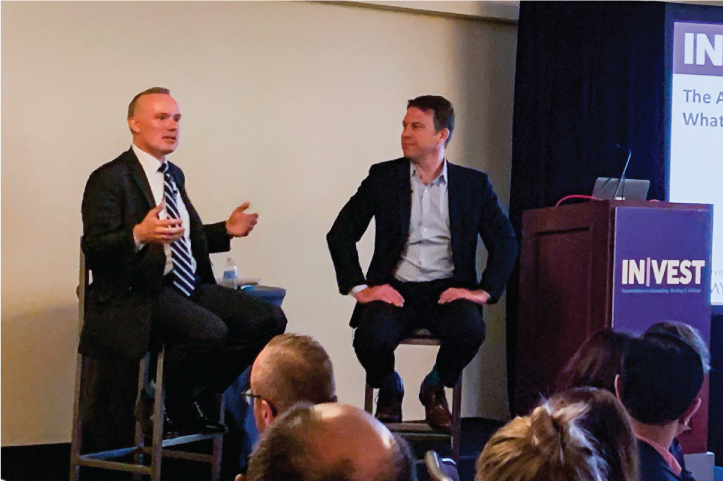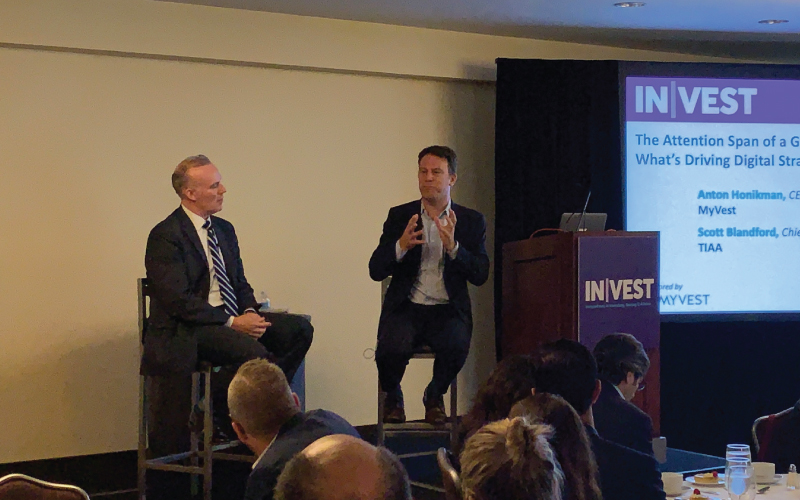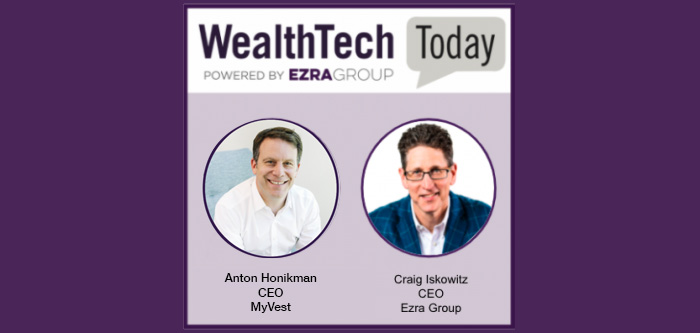Did you know the average human now has an attention span roughly equal to a goldfish?
(Have you stopped reading already? Are you wondering what this has to do with fintech?)
MyVest CEO Anton Honikman and TIAA Chief Digital Officer Scott Blandford presented “The Attention Span of a Goldfish: What’s Driving Digital Strategy at TIAA” IN|VEST 2019’s Industry Innovation Lunch.

In a world where attention spans are limited (to say the least), what’s a 100-year-old financial institution like TIAA doing to break through the noise? Anton and Scott sat down to chat about that, and how MyVest fits into their digital strategy.
Competing for Consumer Attention
Scott: In the pre-mobile world, the human attention span was 12 seconds. Now screens have taken over and changed all of us, and our attention span is 8 seconds — the same as a simple goldfish.
Back in the day you had to pedal your bike down to the library to get information. No there’s more information readily available than anyone can ever consume.
All of this information is competing for one of the final fixed resources in humanity… human attention.
Miller’s Law states that the number of objects a human can hold in their short term memory is 7 (+/- 2), which means when the stack is full, something’s got to go.
So “rule zero” of the attention economy is: give the customer something to care about, then maintain that attention.
Anton: With so many financial institutions there’s the 401K, brokerage, 529, all on separate siloed platforms. They’re not thinking of my experience as a customer, they’re thinking of their products.

Scott: This is Conway’s Law where system interfaces tend to look like the organizational structure of the company that built them. And if your product looks like the org, why not create the org you want?
We’ve pushed the friction back from customers dealing with the silos to having the digital team deal with it. We’re always looking at it from the perspective “what’s right for the customer?”
Digital Lightness
These days we operate with a philosophy of “digital lightness.” It used to be that you jammed as much information as possible at a customer and let them pick what was important. It’s disrespectful to vomit out all that information and make them do all the work.
Now we determine “what’s the next best thing” the customer needs to understand the story or to make a decision?
So you need to be good at finance, technology, and behavioral science. This needs to be in your DNA (versus hiring it out).
We want to guide the customer through the digital storefront. That’s the holy grail.
But we’re digital immigrants, not digital natives. I’ve still got a thriving “paper and postage” company. We’re a 100-year-old company built to fulfill 100-year-old promises.
Partnering with Fintechs
Anton: This is where fintechs can come in and partner with incumbents.
Whereas incumbents are solving broad problems, fintechs are solving narrow problems with creativity.
That’s the beauty of joining forces to serve customers. And if you do right by customers they’re with you (and so are their children and their friends).

Scott: When we were thinking about build versus buy we thought, “hey if we can find a group of engineers and product people who were ahead of their time…”
And we were already working with MyVest, so we said “let’s buy MyVest and do what we can to not screw it up.”
Anton: And three years in, we’re one of the rare success stories of a fintech being acquired and thriving.
Here’s my advice for a successful fintech acquisition:
1) Retain your own brand. Keep separate office space. People at MyVest want to work at a software company, not a financial institution.
2) And keep your own third party business. It keeps you competitive and dynamic.
Scott: Learning how to participate with MyVest has been really valuable. We’ve consulted on Agile development, office design.
When thinking about an acquisition don’t just think about the access to the customers and the software, think about the talent, how to keep it flourishing.
Read more about the MyVest/TIAA success story in Financial Planning’s “How to Make a Fintech Acquisition Work.”
And see the rest of our IN|VEST 2019 highlights.




![MyVest CEO Sees a Tech-Enabled Future Rapidly Approaching [PlanAdviser]](https://myvest.com/wp-content/uploads/PlanAdvisor-Anton-interview-May-2021.jpg)
![We Can Do Better: Making Financial Wellness a Workplace Imperative [BenefitsPRO]](https://myvest.com/wp-content/uploads/MyVest-FacetWealth-financial-wellness.jpg)
